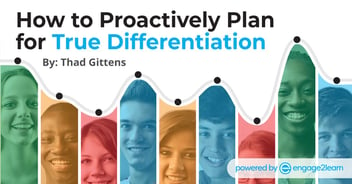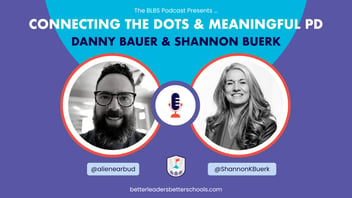3 Steps to Leveraging Education Intelligence in Your District
For decades, educators have poured their time and energy into the next project, the next initiative, the next big thing – anything that promises to help us do right by our students. We do this because the cause is so great, and the impact of not trying feels detrimental, today more than ever. Exacerbated by the pandemic, the urgency to mitigate unfinished learning and a rush of funding has increased the well-intentioned tendency for public school districts to implement more, more, more.
Unfortunately, as the new ideas keep coming, teachers’ and leaders’ already full plates get fuller, and the capacity to effectively implement new initiatives dwindles – at no fault of their own. The lens then becomes a critical one, only focusing on what’s “not working” in education and failing to fully recognize all the good taking place.
It’s important to acknowledge that educators and leaders are doing the absolute best they can with the resources they have. However, it’s time to take the burden off of educators and leaders by connecting the dots to empower them with actionable insights that clearly narrow the focus, limit the new, and strategically abandon anything adding weight without value. As Maya Angelou said:
Do the best you can until you know better.
Then when you know better, do better.
Maya Angelou
To do better, it helps to first identify what we know to be true about the state of public education today:
- Teachers are overwhelmed, burned out, and leaving the profession in droves.
- Students are experiencing widening learning gaps due to systemic inequities and repeated disruptions, especially over the last couple of years.
- Teachers are most successful when they receive individualized job-embedded support and/or coaching.
- Students are most successful when they receive differentiated instruction that meets their unique learning needs.
- Compensation is an essential piece of the teacher retention puzzle, but so are campus culture and climate, social-emotional wellness, intentional support, and recognition.
- Teachers’ professional growth and job satisfaction are directly correlated to improved outcomes and achievement scores for students.
Q: How do we apply what we know better to do better for our students, teachers, and neighborhood public schools?
A: By leveraging Education Intelligence.
But first, what is Education Intelligence?
Since public school educators can’t possibly work any harder, Education Intelligence helps them work even smarter. Education Intelligence is the cyclical process of:
- Requiring all vendors/partners to use smart professional learning that honors and customizes to educators’ differentiated experiences,
- Connecting educator growth data to student outcomes data to ensure educators get the credit for outcomes, and
- Making data-informed decisions about which initiatives are driving student achievement and which are not.
Rinse and repeat!
By collecting and connecting the data, resource-strained educators and administrators no longer have to spend valuable time and energy on ineffective initiatives, technology platforms, student data analyses, or professional development (PD).
Instead, Education Intelligence gives ed leaders a reliable implementation cycle and a clear, data-backed picture of what exactly is most effective for supporting educator growth and student achievement in tandem.
01: Implement smart professional learning as a benefit.
The first step in the Education Intelligence cycle is requiring everyone internally and externally to implement smart professional learning as a benefit to teachers, the antithesis of the traditional, one-size-fits-all PD approach. Rather than requiring teachers to participate in PD that simply ticks a compliance box, smart professional learning is measurable, competency-based and individualized – meeting each teacher where they are to differentiate the path toward mastering best practices that support the fidelity of implementation.
Collecting educator growth data is key in quantifying the efficacy of implementation. With a smart professional learning platform like eSuite, educators have the agency to pinpoint areas in which they’d like to improve, utilize the relevant learning resources that meet their unique needs, and document their progress along the way.
The platform then transforms educator growth into advanced data analytics, empowering ed leaders with actionable insights about how smart professional learning impacts district goals and metrics.
02: Correlate professional growth data to student outcomes data.
Once equipped with educator growth data, ed leaders can monitor and analyze ongoing smart professional learning alongside the student achievement data to determine which initiatives affect learner outcomes and which do not.
Within eSuite, for example, evidence of professional learning is documented in eGroweCoach and transformed into actionable data and reporting in the platform’s impactConsole/impactConsole+. Ed leaders can then import student achievement data to assess educator and student growth side by side.
This process provides leaders with a detailed look into (and an opportunity to celebrate!) campus- and/or district-wide growth trends. It also makes it easy to acknowledge and recognize the growth and efforts of educators, identify areas for improvement – whether in a single classroom, grade level, cohort, or entire campus – and helps clear the path toward improved student engagement and outcomes for the long haul.
03: Make data-informed decisions.
With connected and correlated growth analytics, education leaders can remove guesswork from the equation and make data-informed decisions about where to allocate (and stop allocating) district resources to support teachers effectively, impact student learning, and ensure equity across the board.
In other words, this is where the rubber meets the road. Education Intelligence puts the power of professional growth analytics in educators’ hands, drawing a straight line between professional growth and student outcomes, skyrocketing employee retention, and saving teachers and districts valuable resources. It gives teachers and education leaders the power of clarity and credit when it comes to district and campus initiatives that are making an impact on students – an invaluable tool for empowering educators to empower learners.
Ultimately, Education Intelligence supports educators and leaders in meeting the challenges of public education today with fidelity, intentionality, and, of course, connected intelligence.
—
Want to learn more about harnessing the power of Education Intelligence across your campus or district? Get in touch with our K-12 experts today!
BONUS: Get your copy of the newly released Connect the Dots: Utilize Education Intelligence to Accelerate Growth, Retain Talent, and Optimize Outcomes today!



